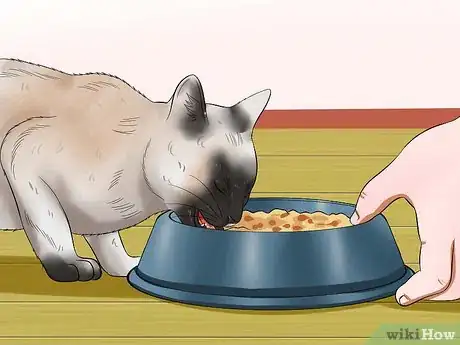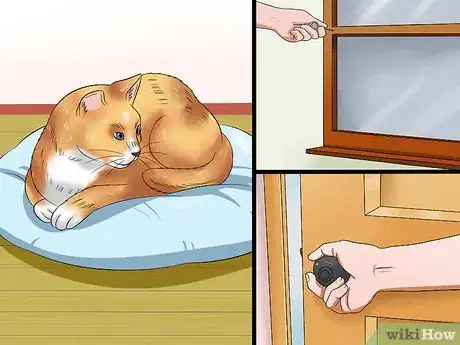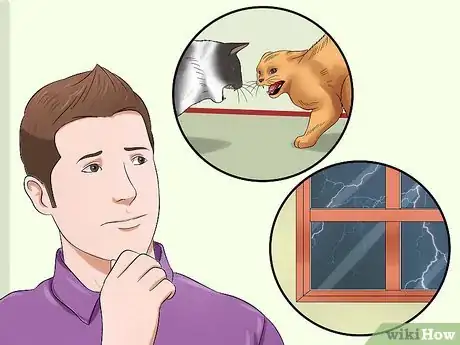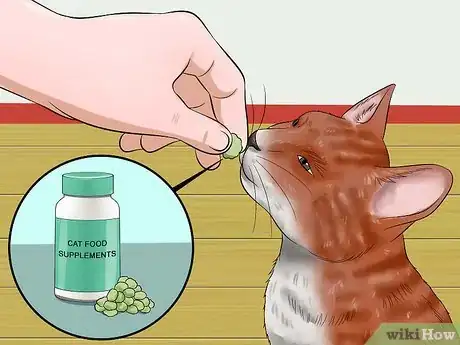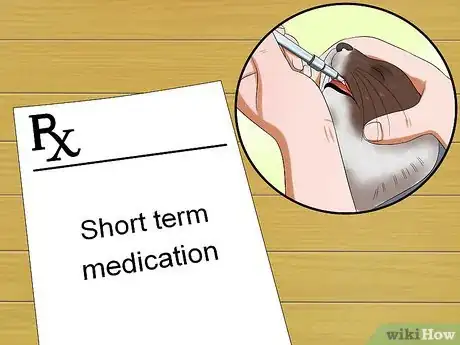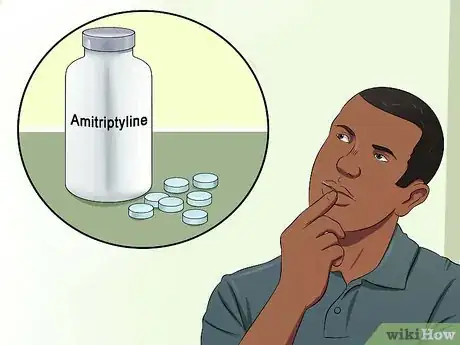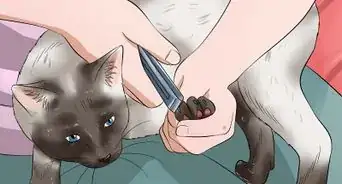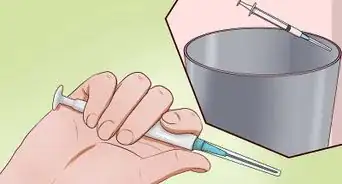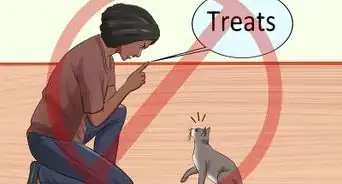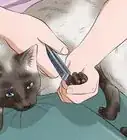This article was co-authored by Brian Bourquin, DVM. Brian Bourquin, better known as “Dr. B” to his clients, is a Veterinarian and the Owner of Boston Veterinary Clinic, a pet health care and veterinary clinic with three locations, South End/Bay Village, the Seaport, and Brookline, Massachusetts. Boston Veterinary Clinic specializes in primary veterinary care, including wellness and preventative care, sick and emergency care, soft-tissue surgery, dentistry. The clinic also provides specialty services in behavior, nutrition, and alternative pain management therapies using acupuncture, and therapeutic laser treatments. Boston Veterinary Clinic is an AAHA (American Animal Hospital Association) accredited hospital and Boston’s first Fear Free Certified Clinic. Brian has over 19 years of veterinary experience and earned his Doctor of Veterinary Medicine from Cornell University.
wikiHow marks an article as reader-approved once it receives enough positive feedback. This article received 14 testimonials and 87% of readers who voted found it helpful, earning it our reader-approved status.
This article has been viewed 347,986 times.
Whether you are a cat lover or not, no one wants to deal with an upset, agitated cat. If a cat gets stressed, they can develop behavioral problems such as litter box avoidance. Cats get upset over many things: car trips, visits to the veterinarian, the noise from loud storms, strangers in the house, a strange cat outside the house, or a variety of other things. If a cat is so upset that it is growling, meowing horribly, or frantically racing around a room seeking a hiding spot, then it may need your help to return to calmness. Begin trying to calm your cat by controlling its environment and giving it some space. If that doesn't work, you may need to consult your veterinarian for medical options that could help your cat.
Steps
Approaching an Excited or Nervous Cat
-
1Think of your and your cat's safety first. Only approach the cat if it is necessary to do so, such as a trip to the vet. The majority of agitated cats benefit from being left in peace, rather than being petted or picked up. If you do have to approach the cat, the very first thing you need to do when your cat is upset is to protect yourself and then the cat. Scared or aroused cats can and will bite their owners and they will scratch. This displaced aggression means your cat is so upset that it will bite or scratch anyone handy if it cannot get at the object or thing making it upset.
- It is imperative that you approach your upset cat with extreme caution.
- Approach the cat cautiously, preferably wearing long sleeves and pants.
- Have a towel handy in case you need to catch your cat.
-
2Use a calm voice and calm behavior. Talk to your cat calmly. For example, say "It's okay, Peaches, it's okay. Shh. Shh." Sit quietly and wait for your cat to calm down, and let it realize you mean it no harm and don't pose a threat.[1]
- Speak quietly and in a lower pitched voice.
- Singing can soothe or relax your cat, much like talking quietly. Singing anything from an upbeat song to a slow melody can work. Just don't sing loudly, harshly, or anything with rapidly changing pitches.
- Play something softly on the TV.
Advertisement -
3Lure the cat towards you. Feed your cat some food if it is still skittish. Wet food is usually more appealing to cats than dry food and fish has an even greater odor than meat.[2]
- Let the cat climb to a higher place to allow it to feel safe and able to see what is going on.
- If possible, stroke the cat's face by running your thumb lightly up from the bridge of the cat's nose.
-
4Move the cat into isolation if it is still upset. Placing the cat in a confined space where it can be alone should help it to calm itself down.[3] Close all doors to the area your cat is in, close shades, blinds, or drapes on windows so it cannot see outside. Remove children and other pets from the area as well. The aim is to provide a calm, non-threatening environment so that cat's anxiety levels fall.
- To move the cat to a room it can be alone in, wrap the cat in a towel snuggly with only its head sticking out, much like a burrito. Then you can place it in a quiet room, like a bedroom, along with access to a litter box, until it is calm once more.
Finding Long-Term Solutions For Nervous or Excited Cats
-
1Figure out what is making your cat agitated. After the emergency is over, you need to reassess the situation. What in particular set your cat off? If it was a one-time occurrence, such as workers in the house, you can anticipate for next time and put your cat in a quiet room until they leave. If it was a stray cat outside, you can use techniques to rid yourself of stray cats, such as water sprinklers or chemical sprays that deter cats from your yard.
- If it is a problem that is likely to recur (such as trips in the car, company, thunderstorms) you can take some steps to help your cat better cope with the situation.
-
2Use pheromones to calm your cat.[4] Pheromones are chemicals released from glands on the cat's body—face, feet, back and tail—that cats release to communicate with other cats. Certain pheromones, such as those released from the cats face when they rub on objects or their humans, have a calming effect on stressed cats.
- Scientists have managed to synthesize these chemicals which come in various forms such as collars, sprays, wipes, and plug-in diffusers.
-
3Use other non-medication calming aids. There are a few other non-medicated options available to calm an anxious or stressed cat. Essential oils or herbal blends can mimic pheromones and can be tried in place of the synthetic pheromones. Food supplements have also proved helpful to relieve anxiety and stress in cats. The ingredients in these supplements help to support the cat’s natural chemical balance to aid in relaxation. They come in liquid, chew and tablet forms.
- Body wraps (thunder shirts or anxiety wraps) are another non-medication calming aids. These cloth and Velcro wraps wrap around the cat’s body and exert gentle pressure on pressure points which aid in calming cats. The principle is similar to swaddling an infant or wrapping the cat into a towel.
- Not every cat will respond positively to having to wear a wrap or to the pheromones or blends. You may have a period of trial and error to see what response your kitty has to these products.
-
4Consider using short-term medication. Some cats have a certain chemical makeup that necessitates the use of medications to help them cope with anxiety or stress producing situations. There are short-term options to use for the occasional trip in the car or visits from certain people your cat has taken a disliking too. Various medications are available to sedate a cat for a short term, temporary situation. These medications require an examination and a prescription from a veterinarian make certain the cat is healthy enough to take them.[5]
- Not all cats react the same to the same medication, so most veterinarians will suggest an initial trial with a medication while at home to gauge your cat’s reaction to the sedative.
- Keep in mind, some sedatives need to be given an hour or so prior to travel or anticipated stressful event so the cat doesn’t override the medication effects due to a buildup of anticipation anxiety.
-
5Discuss with your vet the possible sedatives that could help your cat. There are a broad range of sedatives used in cats. They all have side effects and precautions for use especially in cats with health conditions like kidney failure, heart disease, and diabetes. Only your veterinarian can advise you on the right one for your cat. Sedatives used in cats include:
- Benzodiazepines. Examples are alprazolam, midazolam, and lorazepam. These are the most widely used sedatives in cats. They work almost immediately to reduce fear and anxiety in cats working on the same part of the brain as alcohol does in humans. Note: NEVER give alcohol to a cat.
- SARI’s. Trazodone is an example of this type of sedative. It works quickly to relieve anxiety.
- Clonidine and gabapentin. These have sedative and antianxiety effects in animals including cats.
- Chlorpheniramine and Benadryl are allergy and cold medications which have been used for cat sedation.
- Phenobarbital is another sedative used in cats.
-
6Explore options for long-term medication. There are long-term solutions for those few cats that are suffering from constant anxiety. In cats with severe, crippling anxiety long-term medication (given daily for months to years) is the best solution to make life more pleasant for them and their humans. Luckily, there are now fairly safe medications which can temper down the chemical imbalances which make life miserable.
- These medications include: Amitriptyline (an antidepressant that helps animals with anxiety), Buspirone Hydrochloride (helpful with phobias, such as a fear of people in uniform or a fear of thunderstorms), Clomipramine (Clomicalm), and Fluoxetine (Reconcile, Prozac).
- In order for these drugs to work effectively, they need to “build up” in the cat's body, so it may take up to 6 weeks to find out if they work on the cat.
- Also, they should not be stopped abruptly or adverse effects might occur. The best remedy is to slowly taper down the medication to give the body a chance to adjust to the medication decrease.
Expert Q&A
Did you know you can get expert answers for this article?
Unlock expert answers by supporting wikiHow
-
QuestionMy 5 month old kitten hates being touched. What can I do?
 Pippa Elliott, MRCVSDr. Elliott, BVMS, MRCVS is a veterinarian with over 30 years of experience in veterinary surgery and companion animal practice. She graduated from the University of Glasgow in 1987 with a degree in veterinary medicine and surgery. She has worked at the same animal clinic in her hometown for over 20 years.
Pippa Elliott, MRCVSDr. Elliott, BVMS, MRCVS is a veterinarian with over 30 years of experience in veterinary surgery and companion animal practice. She graduated from the University of Glasgow in 1987 with a degree in veterinary medicine and surgery. She has worked at the same animal clinic in her hometown for over 20 years.
Veterinarian Be patient with the kitten and encourage them to approach you, rather than force your attention on the kitten. Play with toys that are at a distance, such as a wing-on-a-string, which will help the cat to enjoy your company but without them feeling crowded. Also, drop treats as you walk along so the kitten associates you with good things. As the kitten gets used to your company, wait until they rub against you, before touching them briefly. Gradually build up the number of strokes you give the cat but without overwhelming them.
Be patient with the kitten and encourage them to approach you, rather than force your attention on the kitten. Play with toys that are at a distance, such as a wing-on-a-string, which will help the cat to enjoy your company but without them feeling crowded. Also, drop treats as you walk along so the kitten associates you with good things. As the kitten gets used to your company, wait until they rub against you, before touching them briefly. Gradually build up the number of strokes you give the cat but without overwhelming them. -
QuestionAfter I move how can I get an outdoor cat used to being indoors only?
 Pippa Elliott, MRCVSDr. Elliott, BVMS, MRCVS is a veterinarian with over 30 years of experience in veterinary surgery and companion animal practice. She graduated from the University of Glasgow in 1987 with a degree in veterinary medicine and surgery. She has worked at the same animal clinic in her hometown for over 20 years.
Pippa Elliott, MRCVSDr. Elliott, BVMS, MRCVS is a veterinarian with over 30 years of experience in veterinary surgery and companion animal practice. She graduated from the University of Glasgow in 1987 with a degree in veterinary medicine and surgery. She has worked at the same animal clinic in her hometown for over 20 years.
Veterinarian Key to this is making the indoor environment as stimulating and interesting as possible, so the cat can lead a satisfied life indoors. This means providing high perches, plenty of scratch posts, comfortable spots to look out of the window, hiding places, and toys. Also, be sure to actively play with your cat for short periods several times a day. Using puzzle feeders instead of food bowls is also a valuable way to provide mental stimulation.
Key to this is making the indoor environment as stimulating and interesting as possible, so the cat can lead a satisfied life indoors. This means providing high perches, plenty of scratch posts, comfortable spots to look out of the window, hiding places, and toys. Also, be sure to actively play with your cat for short periods several times a day. Using puzzle feeders instead of food bowls is also a valuable way to provide mental stimulation. -
QuestionHow can I calm down my cat who meows uncontrollably and gets very angry and agitated?
 Pippa Elliott, MRCVSDr. Elliott, BVMS, MRCVS is a veterinarian with over 30 years of experience in veterinary surgery and companion animal practice. She graduated from the University of Glasgow in 1987 with a degree in veterinary medicine and surgery. She has worked at the same animal clinic in her hometown for over 20 years.
Pippa Elliott, MRCVSDr. Elliott, BVMS, MRCVS is a veterinarian with over 30 years of experience in veterinary surgery and companion animal practice. She graduated from the University of Glasgow in 1987 with a degree in veterinary medicine and surgery. She has worked at the same animal clinic in her hometown for over 20 years.
Veterinarian
Warnings
- If you reach for a cat and it hisses and/or arches its back, retreat slowly and rethink your strategy.⧼thumbs_response⧽
- Do not bring another animal into the room, it may add to your pet's stress.⧼thumbs_response⧽
References
- ↑ http://www.animalplanet.com/pets/calming-nervous-cats/
- ↑ Brian Bourquin, DVM. Veterinarian. Expert Interview. 20 December 2019.
- ↑ http://www.animalplanet.com/pets/calming-nervous-cats/
- ↑ http://pets.webmd.com/features/pet-pheromone-products-for-behavior-problems
- ↑ https://www.dvm360.com/view/medications-fearful-dogs-and-cats
About This Article
To calm a cat that’s agitated, use a quiet voice, lure it to you with food, and try gently petting it from the bridge of the nose up. You can also move your cat to a quiet space by wrapping it tightly in a towel with only its head poking out so it doesn't scratch or bite you. For cats that are frequently nervous, look at long-term solutions such as collars or sprays that have calming pheromones. Finally, there are medications that your vet can prescribe for short and long-term anxiety, such as sedatives for car trips or antidepressants for anxiety. To learn more from our Veterinarian co-author, like how to determine what's making your cat nervous, keep reading the article!


